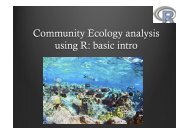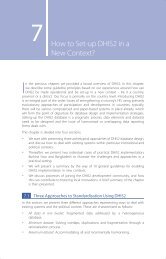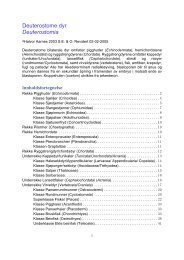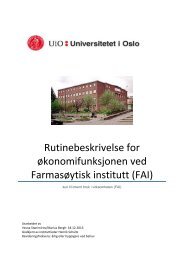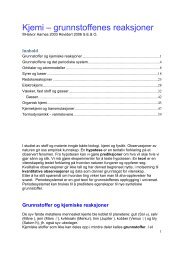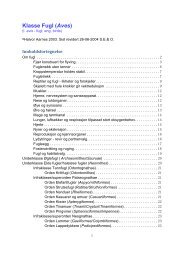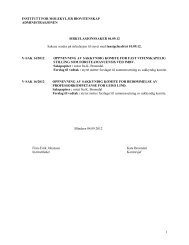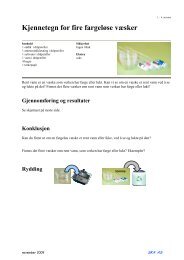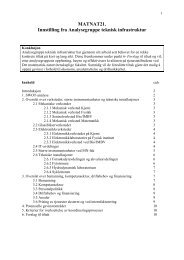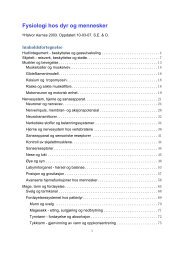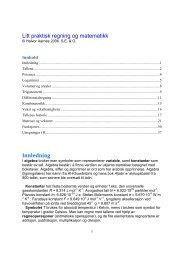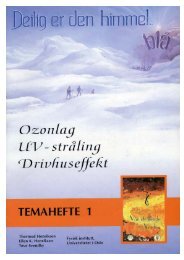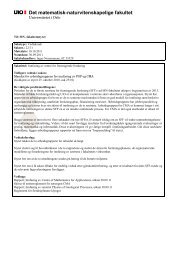Evaluation of individual research units - Norges forskningsråd
Evaluation of individual research units - Norges forskningsråd
Evaluation of individual research units - Norges forskningsråd
Create successful ePaper yourself
Turn your PDF publications into a flip-book with our unique Google optimized e-Paper software.
<strong>Evaluation</strong> <strong>of</strong> biology, medicine and health <strong>research</strong> in Norway (2011)<br />
affairs are also relevant. Environmental monitoring continues to provide a scientific basis<br />
for policy decisions.<br />
Centre for Ecological and Evolutionary Synthesis (CEES)<br />
Grading <strong>of</strong> scientific quality<br />
Excellent<br />
Description <strong>of</strong> unit<br />
The centre consists <strong>of</strong> 18 core members, 46 <strong>research</strong>ers and postdoctoral fellows, 20<br />
technical and administrative personnel, plus PhD and Masters students. Its director<br />
maintains a flat management structure. There is extremely high overall productivity and a<br />
fine training environment for younger scientists. The average age <strong>of</strong> scientific staff is<br />
low, about 42 years. The centre nominally has three themes: (i) the role <strong>of</strong> population<br />
structuring in adaptive evolution, (ii) the potential for adaptation, and (iii) the evolution <strong>of</strong><br />
reproductive isolation. In fact the themes are well integrated. The centre is well<br />
equipped and capable <strong>of</strong> raising extramural support as required.<br />
General evaluation & recommendations<br />
The CEES needs continuity into the future and that is not guaranteed. We recommend<br />
that the centre be integrated into the university and longer-term funding made available.<br />
Much <strong>of</strong> the centre’s <strong>research</strong> is motivated and driven by its highly successful director<br />
who is both an excellent scientist and a visionary scientific administrator. We<br />
recommend succession and contingency planning, perhaps by the appointment <strong>of</strong> two<br />
associate directors. We echo the recommendation <strong>of</strong> the 2000 report to move the<br />
behavioural ecology group from Oslo Museum to a university. The centre might be the<br />
ideal location.<br />
Societal impact<br />
The centre has considerable societal impact. We present four <strong>of</strong> many possible examples.<br />
The centre examines effects <strong>of</strong> climate change marine ecosystems and resource<br />
economics. It has initiated successful start-up companies and commercial enterprises,<br />
and become part <strong>of</strong> a Strategic Institute Programme on the effects <strong>of</strong> fishery harvest. The<br />
centre also sequenced the cod genome, which will allow its population structure to be<br />
analysed in the future.<br />
Microbial Evolution Research Group (MERG)<br />
Grading <strong>of</strong> scientific quality<br />
Good to Very Good<br />
Description <strong>of</strong> unit<br />
MERG was initiated through a strategic program at the Faculty <strong>of</strong> Mathematics and<br />
Natural Sciences, University <strong>of</strong> Oslo. The rationale behind the creation <strong>of</strong> MERG was to<br />
establish a larger and more coherent <strong>research</strong> group capable <strong>of</strong> applying to be a Centre <strong>of</strong><br />
Excellence in Norway in 2012. The Department <strong>of</strong> Biology is the host institution because<br />
most <strong>of</strong> the participants are affiliated with this department.<br />
MERG includes eight pr<strong>of</strong>essors, four associate pr<strong>of</strong>essors, seven post-doctoral fellows,<br />
four engineers, and one administrator. The unit is interdisciplinary with staff affiliated<br />
47




